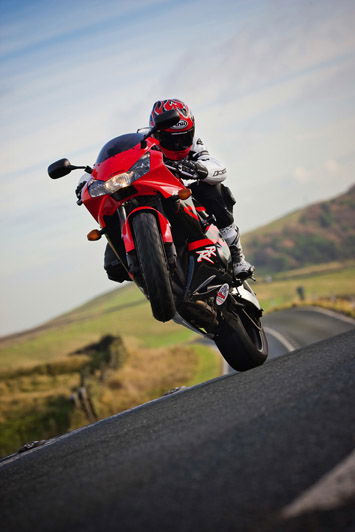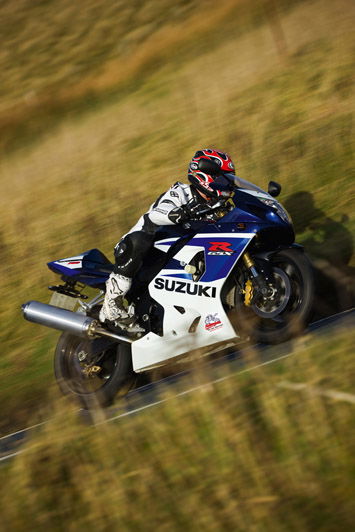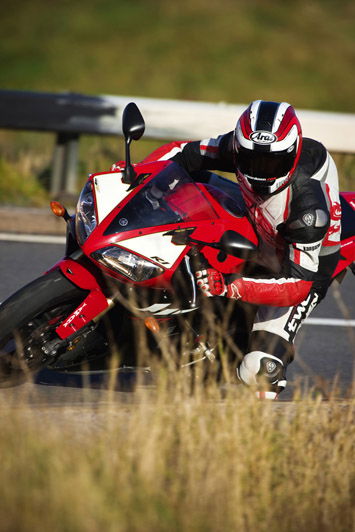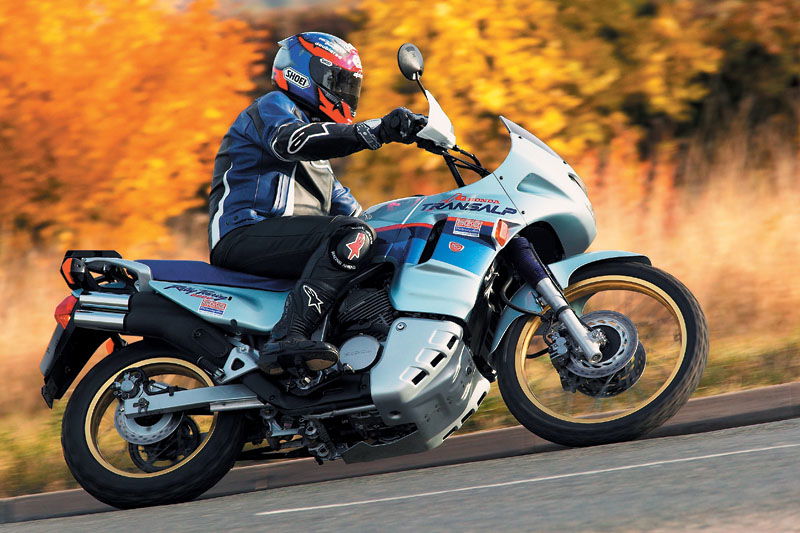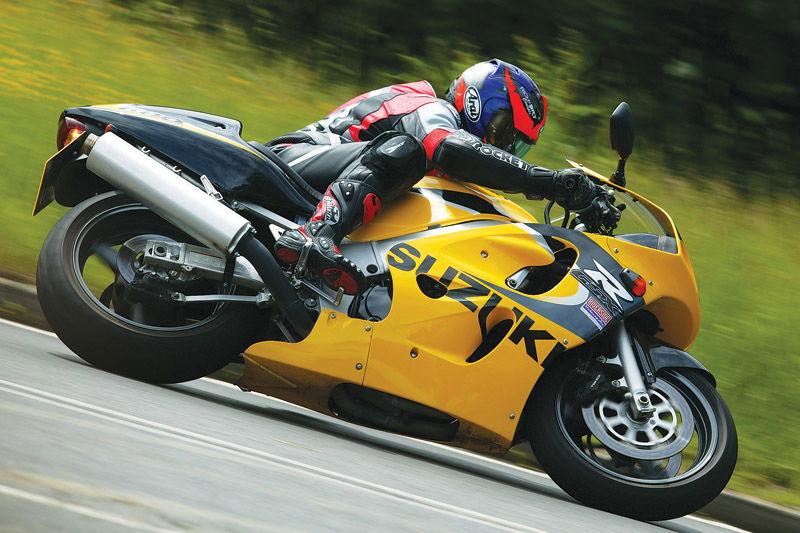Where we were kings: used sports bike test
The quintessential Blade that was so good it was generally overlooked, the underrated GSX-R750 that was admired by those who bought one and the R1 a Japanese bike with styling that matched the Italians


No matter what you may read, here in the UK we are still very much a sportsbike-orientated market with over 25,000 of this type of bike alone sold each year. With that kind of a vast turn-over it’s not surprising that there are so many of them taking up space in secondhand dealers up and down the country. But which one is the best to go for?
In our opinion it’s these three. Honda’s 2002 FireBlade, or the 954 Blade as it’s affectionately known, is the best Blade ever built - fact. And Suzuki’s 2004 GSX-R750 and Yamaha’s 2002 YZF-R1 were the first of the truly stylish Japanese fours. Each of these bikes was slightly over-shadowed in its day by a more headline-attention grabbing rival, but now are proving stars of the secondhand market. And rightly so. These are the epitome of modern classics just waiting to get old.
While the weather outside may not be enticing you to get on a sportsbike, that doesn’t mean that you can’t take advantage of the coating of gloom hanging over your dealer’s showroom and screw a really good deal out of them. Price tags are only a guide in the current climate and money is starting to talk very loudly indeed. Turn up with the cold, hard cash and you might very well walk away with a bargain buy. So why not make it one of these three...
Honda 954 Fireblade
To many, ourselves included, this is the greatest FireBlade that Honda has ever made, and that list includes the current one. Why is it so special?
In 1992 the Blade set new standards when it came to sportsbikes. Lightweight, razor sharp handling and an 893cc engine when all the rest were still squabbling it out in the 750 class. It arrived on the scene and decimated the competition. Then Honda got a bit scared about what they had created and for the next 10 years they kept adding pounds and calming down the twitchy steering. Steadily the Blade’s sharp edge was blunted and when the R1 appeared on the scene the Honda was more akin to a sports tourer than a sportsbike. Then with the 2000 FireBlade Honda re-invented the range.
It was lighter, had a new 929cc engine, and most importantly a new chassis, with the swingarm mounted to the back of the engine to make it even more compact. The FireBlade was back on form and although it couldn’t match the R1, it was close. Two years later it was even better.
In 2002 Honda basically kept the bike the same, but upped the capacity to 954cc and hit the magic formula when it came to a blend of road and track ability. Unfortunately Suzuki had unleashed the GSX-R1000 onto the world a year earlier, so this rather excellent Blade was over-shadowed because the Suzuki was such a missile. The headlines went to the Suzuki, but sensible money went with the Honda.
Six years down the line and there is no way you would look beyond the Honda for the GSX-R1000. When it comes to condition even with 20,000 miles on the clock the Honda looks more than tidy, a GSX-R would be far from as aesthetically pleasing, and it wouldn’t even be on the same ballpark when it came to the ride.
Honda has an uncanny knack of being able to make a sportsbike feel practical, which is why many criticise them as being a little bland. Ride the 954 Blade and you aren’t thinking of discomfort, aching wrists or a buzzy engine, it feels refined, smooth, comfortable and yet is still brimming with character.
The engine is a masterpiece of power and controllability. Near perfect fuel injection meets with instant, yet manageable, drive from a motor that is packed with low down grunt. It feels feisty, fun and has character than future Blades, especially the first underseat pipe 2003 model that followed it, can only ever dream of. For several years Ron Haslam used the 954 Blade on his race school, and it’s this blend of power and control that made it such and ideal learning tool.
But don’t think that this is some middle-of-the-road gent, get the Blade’s motor spinning and it’s incredibly fast. A top speed of 170-plus mph and a genuine 140bhp at the rear wheel are on tap and the handling is up with the very best of its day.
On either the road or track the 954 is excellent. The suspension is super-compliant and the handling fast with out being twitchy. Honda managed to avoid the dreaded steering damper for years simply due to getting the chassis’ geometry correct and not too extreme. Balance, that’s the key.
On the open road you can’t help but be impressed with the Blade’s easy-going handling. Although it will turn quickly when needs be it doesn’t feel like you are riding on a knife edge and that any pot-hole or imperfection needs to be avoided like the plague for fear of smashing your wrists. But should the need arise, wind her open and the Honda responds and transforms into a sharp riding tool that hides that fact the suspension is set quite softly and feels far more focused. And then there are the brakes.
Despite being 20,000 miles and six years old the four piston ‘normal’ brakes on the Honda are stunning. You honestly wouldn’t be upset if you had them on your latest 2009 machine. All the power you could possibly ever need and bags of feel. If they were Suzuki brakes you would be prising the piston from inside the caliper with mole grips after so many miles.
But that is the key to Honda ownership, solid build quality. You never hear of a Blade’s motor going pop, the paint peeling or bits corroding badly. They are built to last and while in 2002 when it was brand new the 954 might not have been the first choice, right now it certainly is, especially at the price. If you are looking at a bike with almost the perfect balance of power, performance and handing then the 2002 954 FireBlade is quite possibly the ideal bike for you.
Owning a Honda Fireblade 954
Running costs: It’s a time-honoured cliché but with Hondas very little does go wrong, so apart from the usual service costs you are unlikely to be stung with any unsuspected shocks. Services are every 4,000 miles. The basic service will set you back around £90, the 8 and 12,000 mile services are will cost about £150 while the 16,000 monster involves valve checks and will put a £450 dent in your wallet. For power these bikes respond well to a Power Commander and pipe.
Other options: The pre-runner to the 954, the 929cc version, is almost identical but lacks a few ccs. It’s a great bike as well but, obviously, not quite as gutsy. prices for these are about £500 - £1,000 cheaper than the 954. The later CBR1000RR Blade has much more power, but lacks a bit of the character as the engine is lethargic. If you like this model fit one tooth less on the front sprocket, it makes a world of difference to the acceleration but makes the speedo read a bit out.
How much: This model Blade still holds its value well, because riders are starting to become wise to its charms. A 2001 model will set you back close to £3,800 with a later 2002 one nearer the £4,300 mark. Go private and you should be looking at parting with £3,200 and £3,800 respectively but in the current climate you can afford to be picky or haggle a decent reduction on this. Red is the most popular colour but the yellow one isn’t that bad in the flesh!
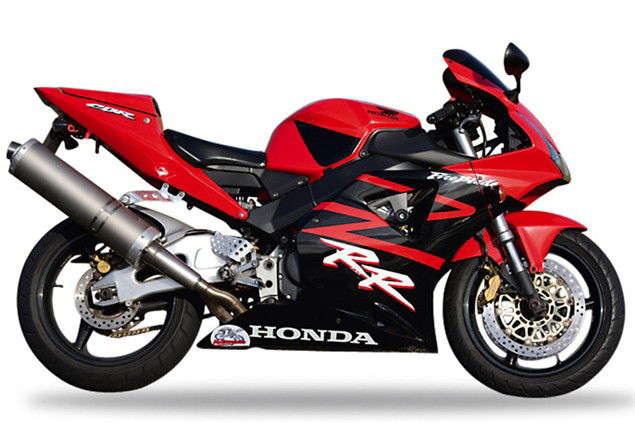
Suzuki GSX-R750
“Reports of my death are greatly exaggerated,” Mark Twain was once (mistakenly) quoted as saying. If ever a quote sums up a motorcycle then this one hits the nail on the head when it comes to the life of the GSX-R750 in recent years.
Ever since the launch of the GSX-R1000 in 2001 people have been predicting the demise of the 750. But every time Suzuki updates the GSX-R600, sure as eggs is eggs, another 750 pops up alongside it. Just why is this?
Simple, not only does the 24-year heritage behind the GSX-R750 mean a hell of a lot to the heads of Suzuki, the bike continues to sell. And sell very well indeed, with figures often topping those of its smaller capacity sibling.
The GSX-R750 is one of those bikes that defies common logic. Why a 750? The 600 is cheaper, almost as fast and looks the same, the 1000 has more power and handles as well. What’s the point in owning a 750? If you think like this then have obviously never ridden one.
The charm of the 750 is that it picks the very best bits of the 600 and 1000 and merges them together into a beautifully balanced bike that is a joy to ride. Nothing on the bike feels like it is trying to fight with the rider, just work with him to make the ride as pleasant and exciting as possible.
Where on a 1000cc bike the sheer speed and brute force of the acceleration is intimidating, and equally on a 600 where the constant need to keep the engine spinning irritating, the 750 is just about perfect. Find a nice piece of road and you feel like you are using the 750’s engine, not being mocked. You can thrash it, hit the limiter, make it scream and giggle like a kid at the buzz, just like a 600. But you won’t ever get that feeling that you are one step behind the action that you can get on a 1000, which is when things can get dangerous. Very quickly.
The 750 engine feels just like you would expect, a 600 with a bit more oomph. A good one will make around the 128bhp area, which is 27bhp more than the 600, which makes a touch over 100bhp. But where the 600 makes just 45ft.lb of torque the 750 will churn out 66ft.lb. That’s quite a difference from just 150ccs, and it feels a massive difference to ride.
The engine is typical Suzuki and transmits a slight tingle through the bars to let you know it isn’t that refined and still has the odd rough edge or two, but nowhere that matters. There is still the killer zap of a powerband at the top end, but the midrange is more than powerful enough to allow the rider to not be continually chasing this band while the fueling is nearly perfect and unlike later Suzukis, the gearbox legendarily sweet.
This 2005 model is special in many ways because it was the last generation before Suzuki started going all stumpy with the exhaust pipe, a move that also signified the advent of a slipper clutch as standard. While this improved the bike’s track ability it did make the gearbox clunky and less precise, removing slightly from its charm.
And that’s the key to the GSX-R750s success – charm. As well as being a brilliant trackday bike the 750 is a superb day to day machine as well. The riding position is roomy and relaxed and the combination of balanced power and the excellent chassis makes it just so easy to ride, even in the wet. Come the dry days, however, and it really comes alive, ripping through corners, flattering the rider’s ability and delivering everything that a GSX-R should. Which has its drawbacks.
As with all Suzuki’s finish is a slight blot on the landscape. It’s not that bad, and certainly far better than early 1000s, but still little things can annoy like the wafer thin paint on the wheels and poor finish on some fasteners, GSX-Rs can look very secondhand very quickly if not looked after and cleaned of any winter sale on a regular basis.
Unlike some other bikes, with the GSX-R750 it really is a case of the latest is the best. If your wallet can withstand the hit then later models are sharper looking, handle that bit better and are slightly more powerful. But, and this is a big but, there is certainly nothing at all wrong with older ones, many prefer the more classic look and slightly easier-going nature.
If you are in the market for your first ‘big’ sportsbike and are looking at the secondhand market for it rather than a brand new one try a GSX-R750. Those few extra ccs make a world of difference without intimidating and we guarantee you won’t regret the choice.
Owning a Suzuki GSX-R750
Running costs: Although it has improved in recent years, at this stage Suzuki’s build quality wasn’t that good. The paint on the wheels is very thin and tyre changes often result in it flaking off. Be aware of this, and also the weak oil seals on the forks, which can pop and will cost about £150 to get changed. Servicing is every 4,000 miles at a cost of about £150 with the biggy involving valve clearances at 15,000 and likely to cost £300.
Other options: With so many years of heritage behind it you have loads of options with the 750. The best earlier model is the SRAD (easily identified by the funny pillion seat cover) which is a great bike or why not go all retro and get an original? Unfortunately they are becoming very collectable and a decent one likely to cost you close to £3,000, which is near the price of a 2002 model! The smaller 600 is a good bike, but lacking a bit of power, whereas the 2005 GSX-R1000 is the best of the 1000s.
How much: Price varies a considerable amount with GSX-R750s depending on age and condition. Above all don’t pay any extra for ‘modifications’ such as rearsets or a race can, and make sure you have the OE can included should the one you are looking at be ‘tuned.’ Suspension mods are good, but it’s very hard to tell if the work has been done. Insist on receipts or assume it hasn’t! A 2004 750 will cost about £4,200 in a dealer or £3,600 private. Add about £400 to each price for the 2005 model.
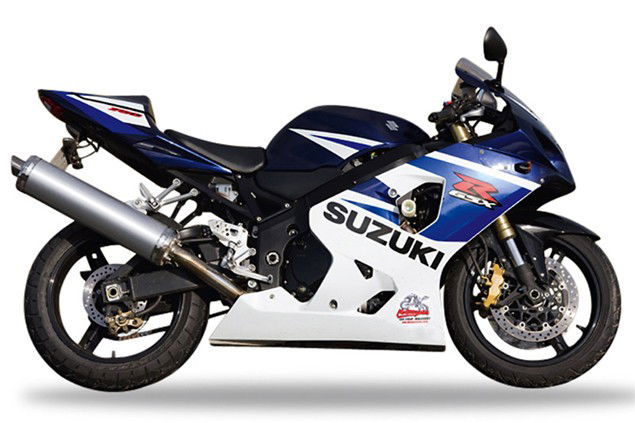
Yamaha YZF-R1
In 2002 the Japanese made a gigantic step forward when it came to bike design. They made a truly good-looking sports 1000. No, better than that, they made an absolutely stunning looking bike and one that really, in its day, rivalled the likes of the Italians. Remember in 2002 Ducati were making the dubious looking 999, Aprilia still the slightly dated RSV-R and MV the beautiful but fragile Agusta. Then along came the R1 with a genuine 140bhp on tap, total reliability and catwalk looks. It was easily the best selling bike of 2002.
After the truly mental original 1998 R1, Yamaha started targeting the 2002 R1 at a more mature rider. A lot like Honda with the Blade, rather than talk power and weight, Yamaha started referring to a more balanced chassis, smoother power and calmer attitude. The Deltabox frame was developing into a considerably less slap-happy beast and in turn so was the R1.
Everything with the 2002 R1 is geared towards making things easier for the rider, except possibly the riding position. Quite what Yamaha thought their more mature riders would make of the very extreme head down, race inspired crouch is a bit of a mystery, because it’s certainly not the comfiest to ride at a gentle pace. Once the speedo gets over 60mph and the road starts to twist it makes sense, but in town and at slower speeds it’s not very much fun at all.
But on these open roads the R1 is excellent. At first the litre engine feels quite odd because it isn’t what you would expect from an R1. There is none of the traditional R1 attitude or slight buzz, no this is silky smooth acceleration that could easily be mistaken for a Honda. But then the R1 rush kicks in. It isn’t all top-endy like a modern R1, but rather just bloody powerful everywhere in the rev range. And fast. Very fast.
The speed the R1’s large and purposeful rev counter whips around is a bit disconcerting, mainly because the pathetically small digital speedo is too discrete for your eyes to register quite what is happening and make sense of the rapidly increasing digits. Some things on this R1 are more style than function, the speedo is one of them. But when you compare it to the likes of a Ducati, which is all style over function, it’s not that bad. The mirrors actually work on the Yamaha at least!
But the handling isn’t quite as refined as Yamaha would lead you to believe. Try and go hard on a slightly bumpy road and the R1 will protest. It’s not even in the same league as the original bike, which would shake like a dog after a swim at the first sign of an uneven surface, but you certainly have to keep on your toes with the 2002 bike. It wasn’t until a few years later that Yamaha took the plunge and fitted a steering damper to the R1, at this point they were still in denial! But the flip side to this is that the R1 has very sharp handing on the road, even more precise than the Blade and simply beautiful for that weekend blast, especially if the weather is hot and roads warm.
Where the Blade excels at everyday use the R1 is a superb weekend toy. Yes, its suspension might be a little on the firm side for touring, but for a sunny day thrash it’s beautiful and works better the faster you go. It’s a bike that needs rider input, not to mention a fair degree of respect, especially of the brakes which are stupidly ferocious. Where the Blade is so user-friendly you can switch off when riding it, the R1 demands attention, but this somehow makes it very satisfying to ride.
And what is also very pleasing is the build quality. The one hidden secret to the 2002 R1, something that only owners really know about, is the fact the build quality is almost on a par with the FireBlade. This 10,000 mile R1 looked almost box fresh. The black finish on the frame and swingarm is inches thick, the plastics fit perfectly together and as long as the titanium pipe avoids anything sharp (it’s very easily scratched) it looks mint for years. And when you have a bike as good looking as this one, it’s worth keeping it looking that way.
Fairly obviously this isn’t a bike for new riders of those looking for a first big bike. The R1 commands more respect than, say, the 954 Blade and a few years riding experience under you belt is recommended before ownership. But if you are looking for a 1000 then the R1 is certainly the best looking bike in its price range and is well worth a very serious consideration. Good used examples are easy to come by due to the owners tending to be slightly more mature than the head-banging GSX-R or ZX-10R rider. Which is only a good thing.
Owning a Yamaha R1
Running costs: Almost as reliable as a Honda but without the reputation. Again, not much goes wrong with an R1 but it’s worth keeping an eye on the brakes as they can get a bit sticky if exposed to the perils of a winter’s neglect. Servicing costs about £210 for a medium service at every 4,000 and £450 for the biggy at 12,000 miles that includes valve clearances and the like.
Other options: The earlier R1 are a bit hectic with the very first model, the 1998 one, being the most hairy. Oddly these are now becoming collectable and prices for a decent one are holding up. The next generation (2000) is largely forgettable and if you want to go older go for the first on. The first generation of underseat pipe R1 is very good, but the engine quite peaky and the handling a bit too much on the stable side to be exciting. Very good on track, but there are more thrilling R1s out there
How much: This model of R1 is yet to make too much of an impact on the secondhand market, and prices reflect this as buyers are lured by the look of underseat pipes. Budget £3,500 for a 2002 model one in a dealer, £2,700 private, with the later 2003 model just tipping over £4,000 from a shop or £3,800 private. As with the GSX-R beware of horrible aftermarket additions and if possible get the stock stuff as well. R1s tend to be modified, but usually tastefully.
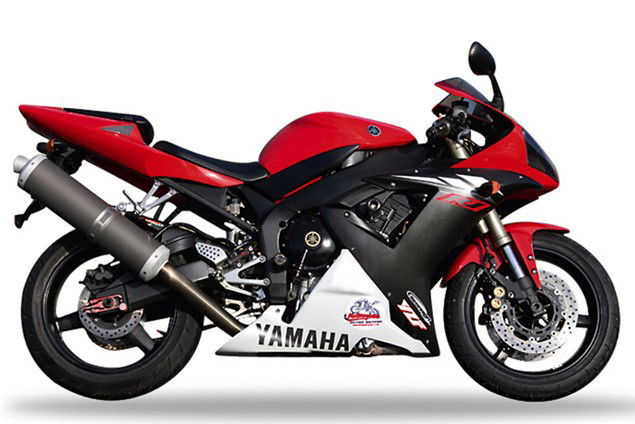
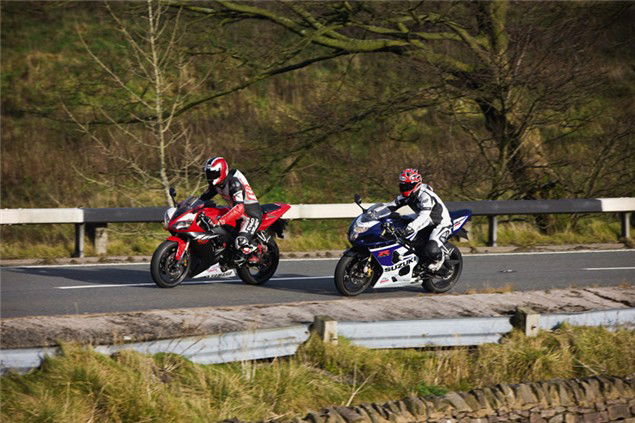
Conclusion
There is a certain amount of pleasure to be had from snapping up a bargain simply because others have been blinded by the draw of new machinery. These bikes have all been born in the shadows of others, but have come out the other side in a far better shape than their original competitors.
Honda’s FireBlade is always going to draw a certain amount of attention because it is an established name, but the beauty of the 954 version is that you have to be a bit of anorak to know that it is this specific model that is so good. While some riders might see the later 2004 Fireblade with its underseat pipe and decide that they will save up the extra to own the newer model they are missing out on owning a far better bike for less cost. The 954 hits the magic formula that is so rare in a sports 1000, it combines the rip-roaring power that you would expect from a litre bike, but puts it in a package that isn’t overly intimidating to ride and is actually very good day-to-day. It’s a beautiful bike to ride, built to last and doesn’t do anything unpleasant on the eye. But it’s no R1.
Even among the latest tackle the 2002 R1 holds its own when it comes to appearance. It has a simple beauty that so many more of the modern machinery struggles to pull off. Sharp without being too pointy but still funky without being cluttered and messy. Then there is the ride.
Where the FireBlade is all about refinement with a slightly rough edge the R1 is super smooth but still raucously fast. When it comes to the crunch the Honda delivers a more pleasant riding experience, but the R1 feels sharper, raw and a bit more thrilling and alive. Many will choose the Yamaha over the Honda simply because it isn’t a Honda, and although they won’t be as happy on the daily commute, they will be over the moon on that sunny day.
Which leaves the GSX-R. Seemingly over looked yet still one of the most popular bikes in the UK. The GSX-R750 has an enormous fan base that keeps on snapping up the new models and justifying to Suzuki its inclusion in their range. To ride it offers a beautiful balance of power and control that is ideal for those who are after a first sportsbike or simply don’t fancy either the idea, or the extra costs involved, of owning a 1000. And who can blame they. Yes, the build quality can be a touch suspect, but you are getting a bike that is two years younger than the others in this test for about the same cost.
Which is the best? That’s a tough question because we have chosen each of these bikes because they are so good. The one that everyone got off and commented ‘I had forgotten these were so good’ was the Suzuki, but the one we would all have considered spending cash on was the Honda. There again the one that turned the most heads was the R1. All things said and done the Honda would probably get the nod, but there is very little in it.
Specifications
2002 Honda 954 Fireblade
Price: £3,800
Engine: 954cc, liquid-cooled, inline four
Power: 140bhp @ 11,200rpm
Torque: 71 lb.ft @ 9,000rpm
Front suspension: USD, fully adjustable
Rear suspension: Monoshock, fully adjustsable
Front brake: 330mm discs, four-piston calipers
Rear brake: 220mm disc, two-piston caliper
Weight: 170kg (claimed)
Seat height: 820mm
Fuel capacity: 18 litres
Top speed: 170mph
Colours: Blue/White, Red/Black, Yellow/Blue
2004 Suzuki GSX-R750
Price: £4,000
Engine: 748cc, liquid-cooled, 16-valve inline four
Power: 127bhp @ 11,100rpm
Torque: 66 lb.ft @ 9,400rpm
Front suspension: USD, fully adjustable
Rear suspension: Monoshock, fully adjustable
Front brake: 300mm stainless steel discs, four-piston calipers
Rear brake: 220mm disc, two-piston caliper
Dry weight: 163kg (claimed)
Seat height: 820mm
Fuel capacity: 17 litres
Top speed: 165mph
Colours: Blue/White and some others
2002 Yamaha YZF-R1
Price: £3,500
Engine: 998cc, liquid-cooled, 20-valve inline four
Power: 140bhp @ 10,500rpm
Torque: 76 lb.ft @ 8,100rpm
Front suspension: USD, fully adjustable
Rear suspension: Monoshock, fully adjustable
Front brake: 298mm discs, four-piston calipers
Rear brake: 220mm disc, two-piston caliper
Dry weight: 170kg (claimed)
Seat height: 820mm
Fuel capacity: 17 litres
Top speed: 169mph
Colours: Red/White, Silver, Blue
